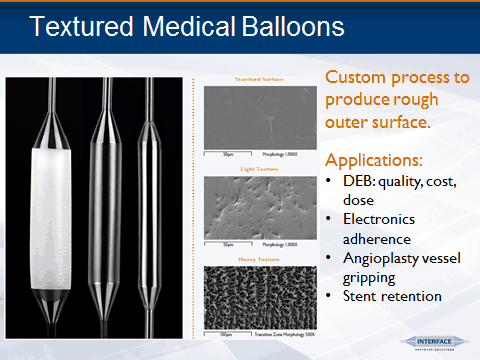December 18, 2012
In the field of interventional cardiology, drug-eluting balloons and flexible electronics mounted to balloons are among the hottest new technologies. While coronary stents--both the bare metal and drug eluting varieties--have revolutionized the field of cardiology, they are not without their drawbacks. Device companies are looking to either improve stents or working on alternate technologies that can address the same problems. For instance, the drug-eluting balloon could prove to be a useful tool in treating stenosed arterial vessels as well as in-stent restenosis instead of the stent.
|
The balloon on the far left was developed by Interface Catheter to facilitate coating with drugs as well as mounting of electronics onto its surface. Image provided by the company. |
To support this evolution, Interface Catheter Solutions (Laguna Niguel, CA) developed a textured balloon technology to facilitate coating with a drug. Normally, the surface of such balloons is very smooth, making it difficult to coat. The traditional method of overcoming this challenge is to first coat the balloon with a polymer, which serves as primer before it is "painted" with a drug layer, explains Mark Geiger, vice president of sales and marketing at Interface Catheter. The company has developed a balloon with a textured surface that avoids the need to be initially coated with a polymer.
As it turns out, the coating supports not just adhesion of drugs but it also facilitates the attachment of flexible electronics. It remains to be seen which of those two areas--drug-eluting balloons or balloons equipped with electronics--will ultimately have a bigger impact on the practice of cardiology. The field of flexible electronics, however, is certainly gaining steam. "With the advent of companies like MC10, the use of the balloon, which is such a familiar platform, could really be extended by using them in conjunction with electronics," Geiger says. "The two applications that have risen to the top in those discussions are renal denervation (RDN) and atrial fibrillation." For treating atrial fibrillation, balloons with electronics mounted onto them can be used to both sense and ablate tissue.
Vessix Vascular's technology provides an example of the advantages of balloon-based renal denervation systems. Above everything, the company's technology is fast. The device can accomplish renal denervation in 30 seconds per artery. In general, renal denervation appears to be highly effective in hypertension that has been nonresponsive to drug therapy.
Within the field of renal denervation devices, balloons aren't used universally, but a growing number of firms active in this field have become interested in balloon based technologies with electronics mounted onto them. "These types of technologies are different from each other but they use a balloon with some sort of electronics mounted to it," Geiger says. "It is really the convergence of the clinical unmet need, the familiar platform in balloon technology, and the advent of flexible electronics that have really allowed this to be realized."
Ultimately, the potential applications of electronics-enabled balloons could be enormous. Although, balloons in general will likely continue to find a growing number of applications. "We are just getting started. Balloons are a bit like baking soda," Geiger says. "We are always discovering new uses for them."
Brian Buntz is the editor-at-large at UBM Canon's medical group. Follow him on Twitter at @brian_buntz.
About the Author(s)
You May Also Like



